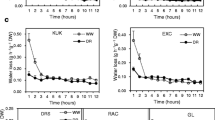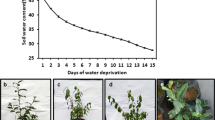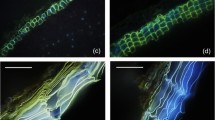Abstract
Cuticular wax is a hydrophobic barrier between the plant surface and the environment that effectively reduces the loss of water. The surface of Welsh onion leaves is covered with wax. To explain the relationship between wax composition and water loss, we conducted this experiment. The water permeability and wax composition of leaves were determined by chemical and GC-MS methods. We performed a comparative analysis of the differences between the two cultivars and analyzed the relationship between water permeability and waxy components. Overall, the permeability to water was higher in ‘Zhangqiu’ than in ‘Tenko’. The wax amount of ‘Tenko’ was 1.28-fold higher than that of ‘Zhangqiu’ and was primarily explained by the much larger amounts of ketones and alcohols in the former. Among the waxy components, C29 ketones were most abundant. There were substantial discrepancies in wax composition, total wax content, and water permeability between the two cultivars. The main reason for the discrepancy in water permeability may be the significantly lower aliphatic fraction in ‘Zhangqiu’ than in ‘Tenko’. This study makes a vital contribution to drought resistance research on allium plants.





Similar content being viewed by others
References
Beisson F, Li-Beisson Y, Pollard M (2012) Solving the puzzles of cutin and suberin polymer biosynthesis. Curr Opin Plant Biol 15(3):329–337
Bernard A, Joubès J (2013) Arabidopsis cuticular waxes: advances in synthesis, export and regulation. Prog Lipid Res 52(1):110–129
Bueno A, Alfarhan A, Arand K, Burghardt M, Deininger A-C, Hedrich R, Leide J, Seufert P, Staiger S, Riederer M (2019) Effects of temperature on the cuticular transpiration barrier of two desert plants with water-spender and water-saver strategies. J Exp Bot 70(5):1613–1625
Burghardt M, Riederer M (2003) Ecophysiological relevance of cuticular transpiration of deciduous and evergreen plants in relation to stomatal closure and leaf water potential. J Exp Bot 54(389):1941–1949
Busta L, Hegebarth D, Kroc E, Jetter R (2017) Changes in cuticular wax coverage and composition on developing Arabidopsis leaves are influenced by wax biosynthesis gene expression levels and trichome density. Planta 245(2):297–311
Caird MA, Richards JH, Donovan LA (2007) Nighttime stomatal conductance and transpiration in C3 and C4 plants. Plant Physiol 143(1):4–10
Chambers TC, Ritchie IM, Booth MA (1976) Chemical models for plant wax morphogenesis. New Phytol 77(1):43–49
Chu W, Gao H, Chen H, Fang X, Zheng Y (2018) Effects of cuticular wax on the postharvest quality of blueberry fruit. Food Chem 239:68–74
Damon SJ, Groves RL, Havey MJ (2014) Variation for epicuticular waxes on onion foliage and impacts on numbers of onion thrips. J Am Soc Hortic Sci 139(4):495–501
Delude C, Fouillen L, Bhar P, Cardinal M-J, Pascal S, Santos P, Kosma DK, Joubès J, Rowland O, Domergue F (2016) Primary fatty alcohols are major components of suberized root tissues of arabidopsis in the form of alkyl hydroxycinnamates. Plant Physiol 171(3):1934–1950
Go YS, Kim H, Kim HJ, Suh MC (2014) Arabidopsis cuticular wax biosynthesis is negatively regulated by the DEWAX gene encoding an AP2/ERF-type transcription factor. Plant Cell 26(4):1666–1680
Gorb E, Haas K, Henrich A, Enders S, Barbakadze N, Gorb S (2005) Composite structure of the crystalline epicuticular wax layer of the slippery zone in the pitchers of the carnivorous plant Nepenthes alata and its effect on insect attachment. J Exp Biol 208(24):4651–4662
Haslam TM, Mañas-Fernández A, Zhao L, Kunst L (2012) Arabidopsis ECERIFERUM2 is a component of the fatty acid elongation machinery required for fatty acid extension to exceptional lengths. Plant Physiol 160(3):1164–1174
Hiscox JD, Israelstam GF (1979) A method for the extraction of chlorophyll from leaf tissue without maceration. Can J Bot 57(12):1332–1334
Huang D, Feurtado JA, Smith MA, Flatman LK, Koh C, Cutler AJ (2017) Long noncoding miRNA gene represses wheat β-diketone waxes. Proc Natl Acad Sci 114(15):E3149–E3158
Jetter R, Kunst L, Samuels AL (2007) Composition of plant cuticular waxes. In: Annual Plant Reviews, Biology of the plant cuticle, vol 23. https://doi.org/10.1002/9780470988718.ch4
Johnson DA, Richards RA, Turner NC (1983) Yield, water relations, gas exchange, and surface reflectances of near-isogenic wheat lines differing in Glaucousness. Crop Sci 23(2):318–325
Kolattukudy PE, Walton TJ (1973) The biochemistry of plant cuticular lipids. Prog Chem Fats Other Lipids 13:119–175
Krauss P, Markstadter C, Riederer M (1997) Attenuation of UV radiation by plant cuticles from woody species. Plant Cell Environ 20(8):1079–1085
Lee SB, Kim HU, Suh MC (2016) MYB94 and MYB96 additively activate cuticular wax biosynthesis in Arabidopsis. Plant Cell Physiol 57(11):2300–2311
Lokesh U, Venkatesh B, Kiranmai K, Nareshkumar A, Amarnathareddy V, Rao GL, Anthony Johnson AM, Pandurangaiah M, Sudhakar C (2018) Overexpression of β-ketoacyl co-a synthase1 gene improves tolerance of drought susceptible groundnut (Arachis hypogaea L.) cultivar K-6 by increased leaf epicuticular wax accumulation. Front Plant Sci 9:1869
Long LM, Patel HP, Cory WC, Stapleton AE (2003) The maize epicuticular wax layer provides UV protection. Funct Plant Biol 30(1):75–81
Martin LBB, Rose JKC (2014) There's more than one way to skin a fruit: formation and functions of fruit cuticles. J Exp Bot 65(16):4639–4651
Olascoaga B, Juurola E, Pinho P, Lukeš P, Halonen L, Nikinmaa E, Bäck J, Porcar-Castell A (2014) Seasonal variation in the reflectance of photosynthetically active radiation from epicuticular waxes of Scots pine (Pinus sylvestris) needles. Boreal Environ Res 19(supplement B):132–141
Patwari P, Salewski V, Gutbrod K, Kreszies T, Dresen-Scholz B, Peisker H, Steiner U, Meyer AJ, Schreiber L, Dörmann P (2019) Surface wax esters contribute to drought tolerance in Arabidopsis. Plant J 98(4):727–744
Rhee Y, Hlousek-Radojcic A, Ponsamuel J, Liu D, Post-Beittenmiller D (1998) Epicuticular wax accumulation and fatty acid elongation activities are induced during leaf development of leeks. Plant Physiol 116(3):901–911
Schuster A-C, Burghardt M, Riederer M (2017) The ecophysiology of leaf cuticular transpiration: are cuticular water permeabilities adapted to ecological conditions? J Exp Bot 68(19):5271–5279
Schuster AC, Burghardt M, Alfarhan A, Bueno A, Hedrich R, Leide J, Thomas J, Riederer M (2016) Effectiveness of cuticular transpiration barriers in a desert plant at controlling water loss at high temperatures. AoB Plants 8:plw027
Sharma P, Madhyastha H, Madhyastha R, Nakajima Y, Maruyama M, Verma KS, Verma S, Prasad J, Kothari SL, Gour VS (2019) An appraisal of cuticular wax of Calotropis procera (Ait.) R. Br.: extraction, chemical composition, biosafety and application. J Hazard Mater 368:397–403
Tendaj M, Mysiak B (2007) Usefulness of Japanese bunching onion (Allium fistulosum L.) for forcing in greenhouse. Acta Agrobot 60(1):143–146
Yeats TH, Rose JK (2013) The formation and function of plant cuticles. Plant Physiol 163(1):5–20
Zhao S, Shi GA, Dong XC (2002) Plant physiology experiment report. Chinese Agriculture Science & Technology Press, Beijing
Funding
This study was supported by the National Characteristic Vegetable Industry Technology System Project (Grant No. CARS-24-A-09), the Double First-Class Discipline Construction Project of Shandong Province (No. SYL2017YSTD06), and the Agricultural Variety Project of the Science and Technology Department of Shandong Province (No. 2016LZGC015).
Author information
Authors and Affiliations
Contributions
All authors contributed to the study conception and design. Kun Xu and Xuena Liu designed the research. Xuena Liu, Song Gao, and Ying Liu performed the experiments. Xuena Liu, Bili Cao, and Zijing Chen analyzed the data. Xuena Liu wrote the manuscript, and Kun Xu revised the intellectual content of this manuscript. All authors read and approved the final manuscript.
Corresponding author
Ethics declarations
Conflict of interest
The authors declare that they have no conflict of interest.
Additional information
Handling Editor: Peter Nick
Publisher’s note
Springer Nature remains neutral with regard to jurisdictional claims in published maps and institutional affiliations.
Rights and permissions
About this article
Cite this article
Liu, X., Gao, S., Liu, Y. et al. Comparative analysis of the chemical composition and water permeability of the cuticular wax barrier in Welsh onion (Allium fistulosum L.). Protoplasma 257, 833–840 (2020). https://doi.org/10.1007/s00709-019-01470-3
Received:
Accepted:
Published:
Issue Date:
DOI: https://doi.org/10.1007/s00709-019-01470-3




